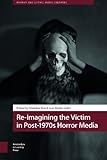Re-Imagining the Victim in Post-1970s Horror Media / ed. by Madelon Hoedt, Marko Lukic.
Material type: TextSeries: Horror and Gothic Media Cultures ; 4Publisher: Amsterdam : Amsterdam University Press, [2024]Copyright date: 2024Description: 1 online resource (256 p.)Content type:
TextSeries: Horror and Gothic Media Cultures ; 4Publisher: Amsterdam : Amsterdam University Press, [2024]Copyright date: 2024Description: 1 online resource (256 p.)Content type: - 9789048555147
- Horror films -- History and criticism
- Horror tales -- History and criticism
- Victims in motion pictures
- AUP Wetenschappelijk
- Amsterdam University Press
- Art and Material Culture
- Cultural Studies
- Fan and Audience Studies
- Film, Media, and Communication
- Media Studies
- LITERARY CRITICISM / General
- Horror studies, victim, audience
- 791.43/6164 23/eng/20240201
- PN1995.9.H6 R45 2024
- online - DeGruyter
| Item type | Current library | Call number | URL | Status | Notes | Barcode | |
|---|---|---|---|---|---|---|---|
 eBook
eBook
|
Biblioteca "Angelicum" Pont. Univ. S.Tommaso d'Aquino Nuvola online | online - DeGruyter (Browse shelf(Opens below)) | Online access | Not for loan (Accesso limitato) | Accesso per gli utenti autorizzati / Access for authorized users | (dgr)9789048555147 |
Frontmatter -- Table of Contents -- Introduction: Theorising the Victim -- 1. Opening the Gate: Reconfiguring the Child Victim in Stranger Things -- 2. Black Death: Black Victims in 1980s Teen Slashers -- 3. Beyond Binaries : The Position of the Transgender Victim in Horror Narratives -- 4. Through the Looking-Glass: The Gothic Victim in Jordan Peele’s Us -- 5. Postmortem Victimhood: Necrovalue in Phantasm and Dead and Buried -- 6. The Sad Killer : Perpetuating Spaces, Trauma and Violence within the Slasher Genre -- 7. “If this is the last thing you see… that means I died” : A Taxonomy of Camera-Operating Victims in Found Footage Horror Films -- 8. Victimhood and Rhetorical Dialectics within Clive Barker’s Faustian Fiction -- 9. Pain Index, Plain Suffering and Blood Measure : A Victimology of Driving Safety Films, 1955–1975 -- 10. Biolithic Horror: Stone Victim/Victimisers in Resident Evil Village -- 11. The Potential Victim: Horror Role-Playing Games and the Cruelty of Things -- Bibliography -- Filmography -- Index
restricted access online access with authorization star
http://purl.org/coar/access_right/c_16ec
Despite its necessary centrality within the genre, the concept of the victim has not received much direct attention within the field of horror studies. Arguably, their presence is so ubiquitous as to become invisible—the threat of horror implies the need for a victim, whose function never alters, often becoming a blank slate for audiences to project their desires and fears onto. This volume seeks to make explicit the concept of the victim within horror media and to examine their position in more detail, demonstrating that the necessity of their appearance within the genre does not equate to a simplicity of definition. The chapters within this volume cover a number of topics and approaches, examining sources from literature, film, TV, and games (both analogue and digital) to show the pervasiveness of horror’s victims, as well as the variety of their guises.
Mode of access: Internet via World Wide Web.
In English.
Description based on online resource; title from PDF title page (publisher's Web site, viewed 20. Nov 2024)


